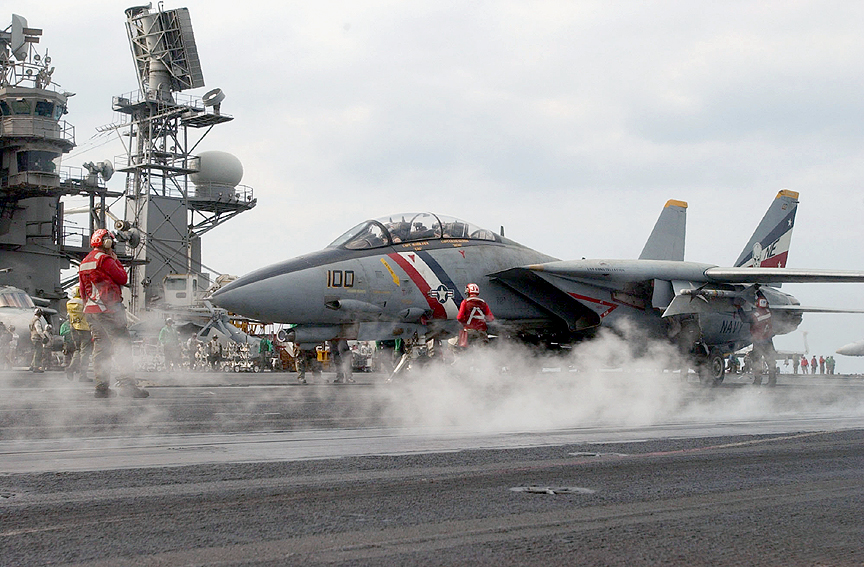F-14 Tomcat Information File:
Grumman’s F-14 Tomcat, a twin-engine, variable-geometry wing, supersonic jet fighter, which was initially designed as a fleet defense interceptor, rose from the ashes of the VFX program under which then Secretary of Defense, Robert Strange McNamara, envisioned a “one size fits all” aircraft that would meet the needs of both the Air Force and the Navy. That program led to the F-111, which became a successful deep strike aircraft for the Air Force, but the F-111B variant, which was to serve as a carrier-based fighter for the Navy, completely failed to meet expectations and was found to be completely unsuitable for carrier operations. But Grumman’s experience with the F-111B, which was also a twin-engine fighter with a variable-geometry wing, led to the development of an entirely new aircraft, the F-14 Tomcat.
The first flight of the first prototype was on December 21, 1970, but the aircraft was lost a few days later on its second flight after experiencing hydraulic failure. But developmental work continued, and the F-14A was made ready for service. It began replacing F-4 Phantoms in Navy fighter squadrons in the early 1970s. The first deployment of Tomcat squadrons was with the Wolfpack of VF-1 and the Bounty Hunters of VF-2 aboard USS ENTERPRISE, CVN-65, to the waters off Vietnam where they provided air cover for the withdrawal of U. S. forces from that country.
Designed as a pure air-defense fighter, the Tomcat was not only armed with the infrared AIM-9 Sidewinder and the AIM-7 radar-guided air-to-air missiles used on most other U. S. fighters of that day, it could also employ the long-range AIM-54 Phoenix missile that had a range in excess of one hundred miles. With terminally active homing guidance, the Phoenix was a fire-and-forget weapon, meaning that the launching aircraft did not have to continue to illuminate the target with its radar while the missile was in flight. With this capability, up to six Phoenix missiles could be launched from a single Tomcat at one time. However, standard practice was to carry a combination of Phoenix, Sidewinder, and Sparrow missiles. Learning a lesson in Vietnam from experience with their F-4 Phantoms, which did not have a cannon armament, the Navy also ordered that the Tomcat be equipped with an internal Vulcan 20-mm cannon.
During its service life, the Tomcat was modified and improved to handle additional roles. Some F-14s were fitted to carry TARPS (Tactical Airborne Reconnaissance Pod System) Pods for reconnaissance work after the last of the RF-8 Crusaders were retired from service. Later, the Tomcat was modified to carry a wide range of air-to-ground ordnance including both dumb and smart weapons, an additional role necessitated with the retirement of the A-6 Intruder. What had begun as a dedicated air defense fighter was developed into an excellent long-range strike fighter capable of attacking ground targets with great precision.
The first version of the Tomcat was the F-14A. This was followed by the F-14B which was originally called the F-14A+. Primary among the changes for the F-14B was that the Pratt & Whitney TF-30-P-412A and TF-30-P-414A engines, used in the F-14A, were replaced with General Electric F110-400 powerplants. An improved Radar Homing and Warning (RHAW) system was also installed. Only 38 new F-14Bs were built, but 48 existing F-14As were also upgraded to F-14B standards.
The final variant of the Tomcat was the F-14D. Like the F-14B, the F-14D had the General Electric GE F110-400 engines, and this version also had a digital avionics system, glass cockpit displays, and the AWG-9 radar was replaced with the AN/APG-71 radar. Other upgrades were made to the electronics systems and the computer. Thirty-seven F-14Ds were built, while eighteen F-14As were upgraded to F-14D standards.
Other than the U. S. Navy, the only other nation to operate Tomcats was Iran, which still has some in service. The U. S. Navy retired the last of its Tomcats in 2006, replacing them with the less expensive, but in many ways less capable, F/A-18E and F/A-18F Super Hornet.
F-14D Tomcat Data
| Length | 62 feet, 9 inches |
| Wingspan | |
| Extended | 64 feet |
| Swept | 38 feet |
| Overswept | 33 feet, 3.5 inches |
| Height | 16 feet |
| Empty Weight | 43,600 pounds |
| Max Takeoff weight | 74,350 pounds |
| Powerplants | 2 X General Electric F110-GE-400 turbofans with afterburners |
| Thrust (Dry) | 13,810 pounds each |
| Thrust (Afterburner) | 27,800 pounds each |
| Fuel Capacity | |
| Internal | 16,200 pounds |
| External | 2 X 267-gallon tanks |
| Maximum Speed | 1,544 miles per hour at altitude |
| Combat Radius | 575 miles |
| Range (Ferry) | 1,600 miles |
| Ceiling | 50,000 feet |






































































